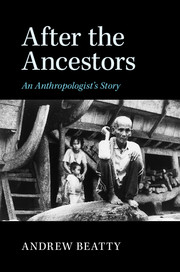Book contents
- Frontmatter
- Epigraph
- Contents
- List of illustrations
- Preface
- People
- Map
- Prologue
- 1 The statue
- 2 House key
- 3 Among women
- 4 Blood brothers
- 5 Daggers and debutants
- 6 Stormy Sunday
- 7 Three things that matter
- 8 The making of great men
- 9 A game of chess
- 10 Cholera song
- 11 Progress
- 12 Brothers and strangers
- 13 Exile and return
- 14 Field work
- 15 The chicken's neck
- 16 Good deaths and bad deaths
- 17 First family
- 18 Blessing
- 19 Half an egg
- 20 Waiting
- 21 Death of a chief
- 22 Ama Jonah at bay
- 23 Unravelling
- 24 The ethnographer and his double
- Epilogue
- Index
6 - Stormy Sunday
Published online by Cambridge University Press: 05 March 2015
- Frontmatter
- Epigraph
- Contents
- List of illustrations
- Preface
- People
- Map
- Prologue
- 1 The statue
- 2 House key
- 3 Among women
- 4 Blood brothers
- 5 Daggers and debutants
- 6 Stormy Sunday
- 7 Three things that matter
- 8 The making of great men
- 9 A game of chess
- 10 Cholera song
- 11 Progress
- 12 Brothers and strangers
- 13 Exile and return
- 14 Field work
- 15 The chicken's neck
- 16 Good deaths and bad deaths
- 17 First family
- 18 Blessing
- 19 Half an egg
- 20 Waiting
- 21 Death of a chief
- 22 Ama Jonah at bay
- 23 Unravelling
- 24 The ethnographer and his double
- Epilogue
- Index
Summary
When the Bible is rewritten in an exotic tongue, its sense is changed, and so is the target language. The German translator of the Nias Bible (published in 1905), a Lutheran missionary named Sundermann, chose the name Lowalangi for the biblical God. In a crowded pantheon there were several candidates, none quite right. Sirao, a tribal progenitor, was too worldly and belonged to the Niha alone. Sihai, an obscure creator, was remote and prone to error. The sungod Lowalangi came with a younger brother, god of the underworld – clearly a drawback – but he was roughly in the right place and properly distinct from the world of humans. In Sundermann's hands, he would leave the timeless zone of myth to enter human history, becoming a different kind of deity – interfering, vengeful, moralistic. A desert god for a forest people.
What is it to reconstruct a religion, a worldview, a way of life? It now strikes us as an act of hubris. Yet at the time it must have seemed, more than anything, an act of faith: faith in the Word, certainly; but faith, also, in the power of the printed word. Nias was rich in oral traditions, but the language was unwritten. There was no cultural standard except custom, which varied from valley to valley; no Truth outside human experience. In a land without books, one book would change everything. Local myths, attuned to local realities, would give way to a single universal story, unchanging and unchangeable. From being the centre of the world, Nias would diminish to a speck on someone else's horizon. And for the people of Nias, the Niha, a silent walk-on role at the end of the cosmic drama.
But it takes more than a good story to persuade people to abandon their gods. Something solid had to give way before the new narrative made sense.
- Type
- Chapter
- Information
- After the AncestorsAn Anthropologist's Story, pp. 89 - 103Publisher: Cambridge University PressPrint publication year: 2015

